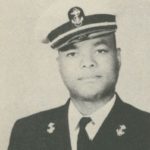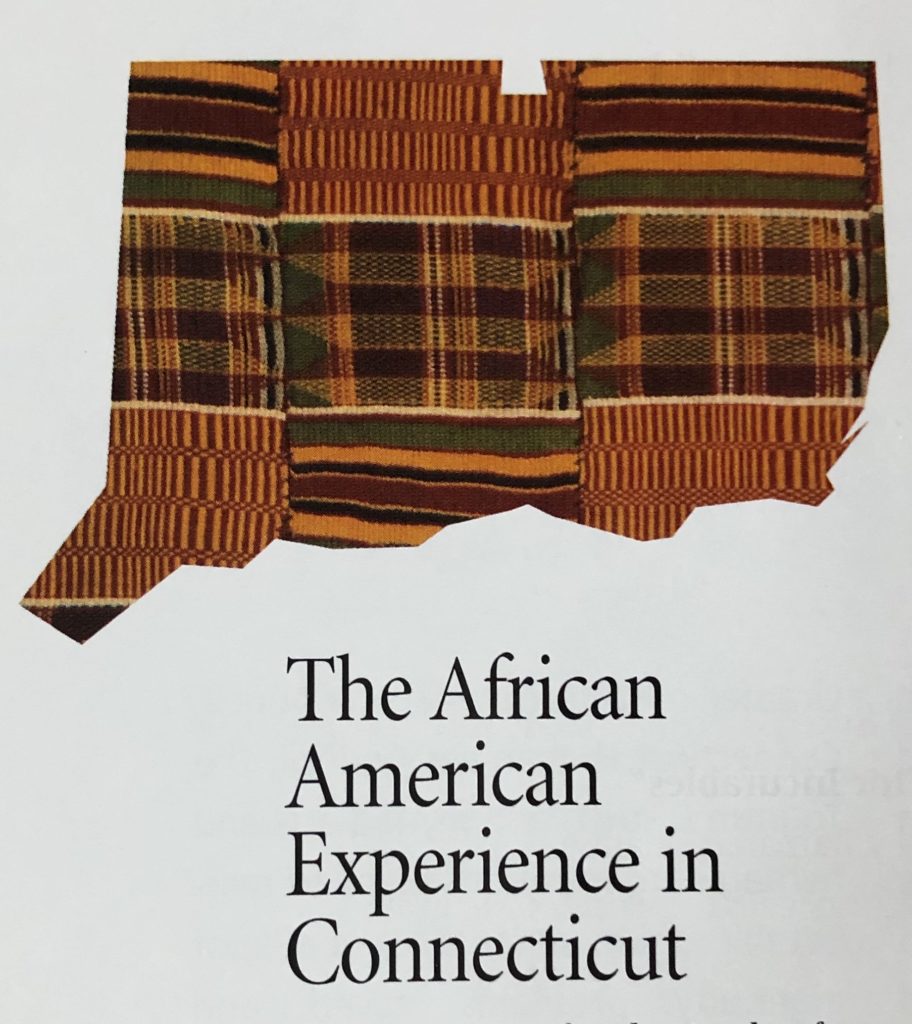 Stories from back issues of Connecticut Explored and episodes from our companion podcast Grating the Nutmeg tell about the long arc of the African American experience in Connecticut.
Stories from back issues of Connecticut Explored and episodes from our companion podcast Grating the Nutmeg tell about the long arc of the African American experience in Connecticut.
See the bottom of the page for the books:
African American Connecticut Explored
Venture Smith’s Colonial Connecticut
Audacious Alliances: Mary Townsend Seymour
Summer 2003
Seymour was a founder of the Hartford chapter of the NAACP, and an activist for African American rights in early 20th century Hartford.
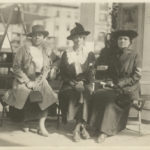
Mary A. Johnson (center) with Elizabeth R. Morris (left) and Rosa J. Fisher (right) representing Hartford’s Colored Women’s Liberty Loan Committee, 1918. Photographer Edward M. Crocker, The Hartford Courant, State Archives, Connecticut State Library
Uncovering African American Women’s Fight for Suffrage
Summer 2020
Read the story and listen to the Grating the Nutmeg podcast, Ep. 97
World War II – Connecticut’s Own Rosie the Riveter
Fall 2003
Primary source: an iconic image of women welders in New Britain by famous photographer Gordon Parks.
World War I – Parallel Lives: Segregation in World War I
2003 Nov/Dec/Jan 2004
Civil War – Fighting for Freedom: Joseph O. Cross
Fall 2003
This primary source letter from soldier Joseph Cross to his wife reveals the experience of an African American soldier from Connecticut fighting in the Civil War.
A Life’s Work: Excerpts from Life of James Mars, A Slave Born and Sold in Connecticut, Written by Himself
Summer 2004
Freed by the Gradual Emancipation Act, James Mars published his life story in 1868. He wrote about equality, racial privilege, faith, and citizenship.
Actress Gwen Reed: From Fields to Footlights
May/Jun/Jul 2004
Actress Gwen Reed’s star shone bright in productions for the WPA Federal Theater Project and the Hartford Stage Company, all while paying the bills as a paid spokesperson for the Quaker Oat Company playing “Aunt Jemima.”
“Governor Greets College Girl”
Fall 2002
A young Betty Powers of Hartford, then president of the Bennett College for Women student senate, met her home-state governor, Raymond E. Baldwin, in 1946.
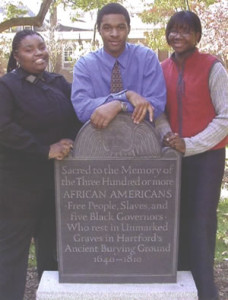
Hartford students Andriena Baldwin, Christopher Hayes, and Monique Price with the African American Monument they researched and raised the fund to erect, 1998. photo: Billie M. Anthony
Monument to the Black Governors
Fall 2004
The story of Connecticut’s colonial-era Black leaders.
The Hartford Chapter of the Black Panthers: An interview with Butch Lewis
Fall 2004
The New Haven Black Panther Trials
Winter 2019-2020
PODCAST: The New Haven Black Panther Trials, Grating the Nutmeg episode 111
re: Collections–Photographer Augustus Washington
Winter 2004/2005
Augustus Washington became a successful early photographer before emigrating to Liberia and becoming one of its most distinguished citizens.
Augustus Washington: Finding Freedom Through the Daguerreotype
Fall 2021
From Talcott to Main Street: Hartford’s First African-American Church
Summer 2005
The church has historically been a pillar of the African American community.
Farmington’s Stops on the Underground Railroad
Fall 2005
Fortune’s Story
Spring 2007
When an enslaved man named Fortune died in Waterbury in 1798, his owner, a doctor, preserved Fortune’s skeleton as a medical specimen. Fortune’s skeleton was displayed at the Mattatuck Museum until a project to understand and honor Fortune’s dignity resulted in more respectful treatment of his remains.
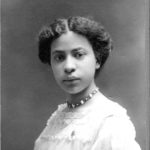
Anna Louise James, the author’s great-aunt, was born Louise Cleggett James. Graduation photo, Brooklyn College of Pharmacy, 1908. Courtesy of Elisabeth Petry
James Pharmacy
Spring 2007
Anna Louise James was the first African American female pharmacist in Connecticut. She ran her own pharmacy in Old Saybrook from 1917 to 1967.
Searching for My James and Lane Families
Fall 2019
Journalist Liz Petry explores her family tree, with roots in slavery and branches that include a best-selling novelist and Connecticut’s first African American female pharmacist.
Novelist Ann Petry: “Just Like Georgia Except for the Climate”
Fall 2014
The best-selling novels of Ann Petry of Old Saybrook, Connecticut tell the story of Black America in the mid-20th century.
PODCAST: Novelist Ann Petry and Exploring the Family Tree
Liz Petry’s lecture at the Mark Twain House explores her family tree and her family’s connection to the writer Mark Twain.
Women Who Changed the World
Summer 2011
Including a short bio of Novelist Ann Petry
“Cast down on every side”: The Ill-Fated Campaign to Found an “African College” in New Haven
Summer 2007
Abolitionists and Black leaders proposed the first Black college in the United States in New Haven in 1831.
My Dad, Jackie McLean
Fall 2008
The story of jazz legend Jackie McLean told by his daughter.
Marian Anderson Studio
Fall 2008
The famed opera singer lived in Danbury. Her studio is on the Connecticut Freedom Trail.
A Family of Reformers: The Middletown Bemans
Winter 2008/2009
An African-American family fights for equal opportunities in ante-bellum Middletown.
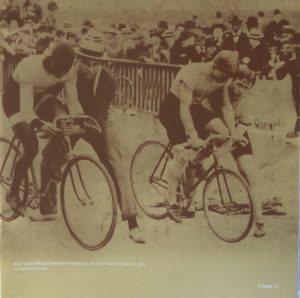
Major Taylor (left) and William Fenn (right) face off at the Newark Velodrome, 1901. US Bicycle Hall of Fame
Marshall “Major” Taylor & William Fenn: The Fastest Men on Two Wheels
Fall 2009
Major Taylor found fame, fortune—and racism—as a bicycle racer in turn-of-the-20th century Hartford.
My Summers at Camp Courant. By Chief Charles A. Teale, Sr.
Summer 2010
At a particularly tough time in the childhood of the future Hartford Fire Chief, Camp Courant filled Charles Teale’s summer days.
Site Lines: Black Abolitionists Speak
Spring 2011
Black people had resisted slavery and fought for its abolition even before the formation of the Union in 1776. In Connecticut in 1779, 1780, and 1788 African Americans petitioned the Connecticut General Assembly to abolish slavery. Here are feature the words of some of Connecticut’s leading Black abolitionists, spoken and written, as they strove to be front and center in all aspects of the struggle for their human rights.
The 29th Regiment Colored Volunteers
Spring 2011
The story of Connecticut’s Black Civil War regiment.
The Fisk Jubilee Singers Tour the North
Spring 2011
The Black Church: Fortresses of Faith, Agents of Change
Summer 2011
The history of Connecticut’s earliest Black churches.
Laboring in the Shade
Summer 2011
Heading north for a summer job in the tobacco fields.
“What Would Dr. King Want You to Do?”
Fall 2011
Hartford High School students marched to City Hall after Dr. King was assassinated in 1968.
“I Wanted to Fly”
Fall 2011
Tuskegee Airman Connie Nappier learns to fly in World War II.
Ebenezer Bassett’s Historic Journey
Winter 2011/2012
Our first Black diplomat serves the first Black republic.
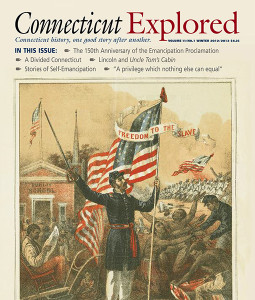 The 150th Anniversary of the Emancipation Proclamation, Winter 2012-2013
The 150th Anniversary of the Emancipation Proclamation, Winter 2012-2013
Promise of Freedom: Reflections on the Emancipation Proclamation
Winter 2012-2013
Connecticut’s Response to the Emancipation Proclamation
Winter 2012-2013
Rev. James Pennington: A Voice for Freedom
Winter 2012-2013
Nancy Toney’s Lifetime in Slavery
Winter 2012-2013
Nancy Toney of Windsor may have been the last enslaved person in Connecticut.
Life & Adventures of Venture, a Native of Africa
Winter 2012-2013
Venture Smith: “Thanks for My Gold Rings”
Winter 2021-2022
Adam Jackson’s Story Revealed
Spring 2013
Joshua Hempsted documented the life of Adam Jackson, who he enslaved for more than 30 years, in his diary.
Southern Blacks Transform Connecticut
Fall 2013
In the early 20th century, Blacks from the south migrated north—including to Connecticut—transforming the Black community that had been in Connecticut since colonial times in profound ways.
The Trailblazing Bessye Bennett
Spring 2014
The history of Black men and women in the legal profession, with a focus on Connecticut.
Henry Green and the Final Underground
Summer 2014
The long working-relationship of Henry Green and President Abraham Lincoln’s secretary of the navy and how Green came to be buried in Hartford’s Cedar Hill Cemetery.
Actress Marietta Canty
Spring 2015
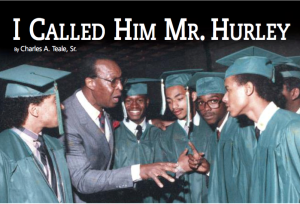 Coach Walter “Doc” Hurley: “I Called Him Mr. Hurley”
Coach Walter “Doc” Hurley: “I Called Him Mr. Hurley”
Fall 2015
Cricket Comes to Hartford
Spring 2003
African American Greats in Connecticut Baseball
Spring 2018
PODCAST: Before 42: Ball Players of Color in Connecticut
30 minutes
The Hannah Gray House
Fall 2015
After a lifetime of low-wage work, Hannah Gray of New Haven left a lasting legacy.
No Taxation with Representation: African American Voting Petitions
Spring 2016
After Black men were disenfranchised by state law in 1814, African American men and women petitioned the Connecticut General Assembly for their full rights as citizens.
Isaac Glasko Forges a Life
Summer 2016
The story of the man for whom the village of Glasgo in the town of Griswold is named.
Remembering Bristow
Summer 2017
The enslaved man for whom a middle school in West Hartford is named.
Double Exposure: The Importance of Photography in Telling the African American story
Fall 2017
Greater Hartford NAACP: 100 Years in the Freedom Struggle
Fall 2017
Rights for All? The History of African American Suffrage in Connecticut
Fall 2018
Where the Constitution of 1818 Fell Short
Fall 2018
Connecticut’s 1818 state constitution is silent about slavery and disenfranchised Black men. How did that compare to other New England states?
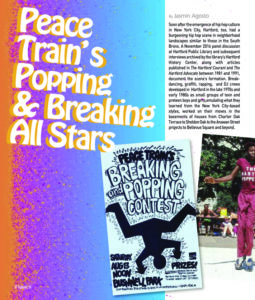 A Hip Hop History: Peace Train’s Popping & Breaking All Stars
A Hip Hop History: Peace Train’s Popping & Breaking All Stars
Winter 2018-2019
Embracing Artist Ellis Ruley of Norwich
Winter 2018-2019
PODCAST: Educated for Freedom
State historian Walt Woodward interviews UConn English professor Anna Mae Duane about her book about James McCune Smith and Henry Garnet, two African American boys who met as young students at the New York African Free School on Mulberry Street. Their intertwined lives of antebellum antislavery activism helped define the possibilities for Blacks in American Society.
Unburying Hartford’s Native and African Family Histories
Fall 2019
Not only Puritans were buried in Hartford’s first cemetery.
PODCAST: Uncovering African and Native American Lives in 17th & 18th Century Hartford
PODCAST: Department Stores, Hartford’s G. Fox & Co., and the Black Freedom Movement
UMass’s Dr. Traci Parker, with some editorial commentary from Connecticut Historical Society’s Natalie Belanger, talks about what department stores like G. Fox meant to consumers and retail workers alike, and how they become sites of struggle in the civil rights movement of the 1960s.
How Segregation Happened in West Hartford
The Federal Government and Redlining in Connecticut
Summer 2019
PODCAST: The Challenge of Fair Housing in Connecticut’s Suburbs
PODCAST: Norwalk’s Village Creek Ahead of its Time
After World War II, one Connecticut community made a conscious effort to reject racial segregation. The founders of Village Creek in Norwalk created a cooperative neighborhood which promised not to discriminate based on “race, color, creed or politics.”
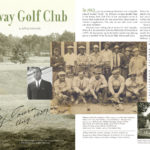 The Midway Golf Club
The Midway Golf Club
Summer 2018
The club for African American golfers and breaking the color line at Keney Park golf course in Hartford.
PODCAST: Breaking Golf’s Color Line in Hartford
Hartford native Gerry Peterson has played golf with President Barack Obama and was inducted into the Black Golf Hall of Fame in 2015. He started as a young caddie during the Depression and played as a newly-minted executive at Aetna Life and Casualty. But what did it take for Peterson to become a member of the whites-only Keney Park Golf Club in 1963?
No Day at the Beach
Summer 2019
Advocating for eliminating racial barriers at Connecticut’s beaches.
“The Wade in of 1964”
Summer 2019
State historian Walt Woodward describes Rev. William Philpot’s campaign to use his beach rights at his cottage on Andover Lake in the 1960s.
Grave Deeds and Abandoned Cemeteries
Summer 2019
Preserving a “Colored Cemetery” in Greenwich.
PODCAST: Hopes and Expectations: Creating a Black Middle Class in Hartford
Historian Barbara Beeching describes the creation of a Black middle class in Hartford – not in the 20th century, but in the 1800s.
PODCAST: Greater Hartford’s West Indian Diaspora
In 2010, Jamaicans became the largest foreign-born population in Connecticut and have the highest percentage of property ownership in Hartford County of any foreign-born group. UConn associate professor Fiona Vernal tells how so many West Indians come to call Connecticut home.
PODCAST: Art, Agency, Legacy: 30 Years of The Amistad Center for Art & Culture
The Amistad Center for Art & Culture in Hartford documents the history and art of people of African descent in America.
Slave Quarters in Bush-Holley House
Spring 2020
The Greenwich Historical Society tells the story of the slave quarters in its historic house. Joseph McGill of The Slave Dwelling Project slept there in 2012.
Connecticut’s Green Book Sites
Spring 2020
Traveling while Black—in Connecticut and elsewhere—required advanced planning and a copy of The Green Book.
Did Slavery Just Happen in the South?
The life story of James Mars of Norfolk, Connecticut and other resources connecting slavery in the South to slavery in Connecticut.
PODCAST: 400 Years of African Americans in Connecticut
Interview with Dr. Katherine Harris, then a lecturer at CCSU, about the 400 years of African Americans in Connecticut, and African American Connecticut Explored.
Sarah Boone Invents a Better Ironing Board
Summer 2020
World War II Vet Al Stewart Tells His Story
Fall 2020
Commemorating the 75th anniversary of the end of World War II, read the story of trailblazer Ensign Albert C. Stewart, including a link to his interview on Youtube.
The Reverend Richard A. G. Foster’s Unheralded Sojourn in New Haven
Summer 2021
Rev. Foster came from North Carolina to minister to his community—and the City of New Haven.
Seeking Racial Equity in Norwalk’s Village Creek
Summer 2021
A small community in Norwalk has been doing the work of seeking racial equity since 1949.
Constance Baker Motley’s Chester Retreat
Summer 201
The State Historic Preservation Office dedicated the Chester property of Judge Constance Baker Motley as the Connecticut Freedom Trail’s 140th site.
Rediscovering William Grimes, the Runaway Slave
Winter 2021-2022
Regina Mason finds her family in a fugitive slave narrative.
William Lanson: An Artisan Who Built Beyond Structures
Spring 2022
The West Indian Social Club, A Home Away from Home
Summer 2022
Frederick Douglass in New London
Summer 2022
Site Lines: The Robesons Move to Enfield
Summer 2022
PODCAST: 145. Activists Paul and Eslanda Robeson in Connecticut
How Hartford’s North End Became an African American Community
Fall 2022
PODCAST: 149. New London and the Middle Passage (CTE Game Changer Series) In this podcast episode, Kathy Hermes, Lonnie Braxton, and Tom Schuch discuss the Speedwell, a ship that brought 74 enslaved West Africans to Connecticut in 1761 and Normand Morison, the man who enslaved 21 of them; New London’s Black Heritage Trail and its significance; and the impact of the slave trade on Connecticut and its trading networks.
Fall 2022
The People Make History
Fall 2022
Kids’ Page: Jackie Robinson Changes the Game
Fall 2022
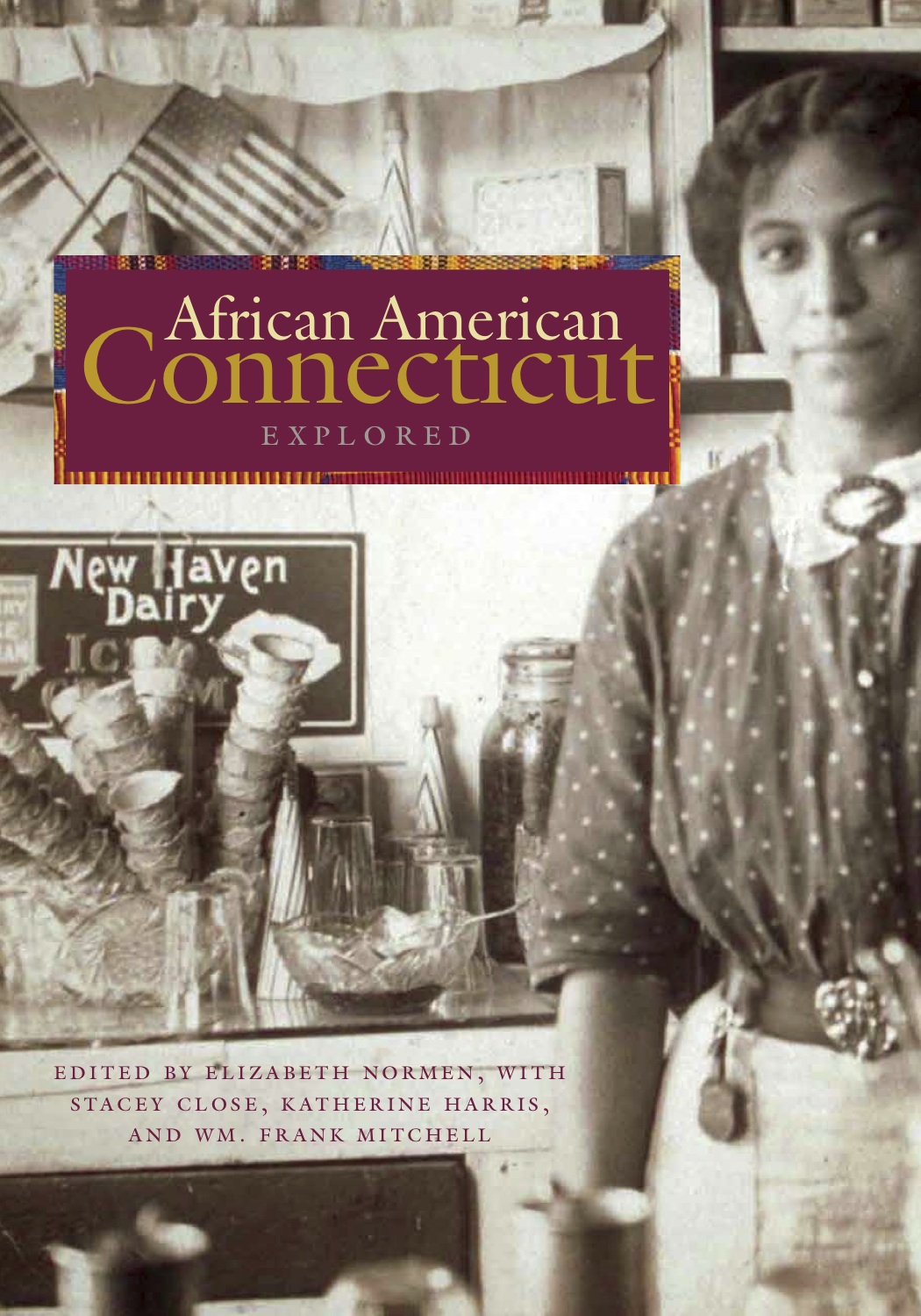 THE BOOK
THE BOOK
Four hundred years of the African American experience in Connecticut. Published by CT Explored and Wesleyan University Press, 2014.
Purchase HERE
Wesleyan University Press is now offering a 30% discount for visitors to their Web site. Enter the discount code Q301 when ordering through the link above. All of our orders are processed by Hopkins Fulfillment Services, HFS, or call 800-537-5487 to place your order.
For grades 5 and up
Venture Smith’s Colonial Connecticut
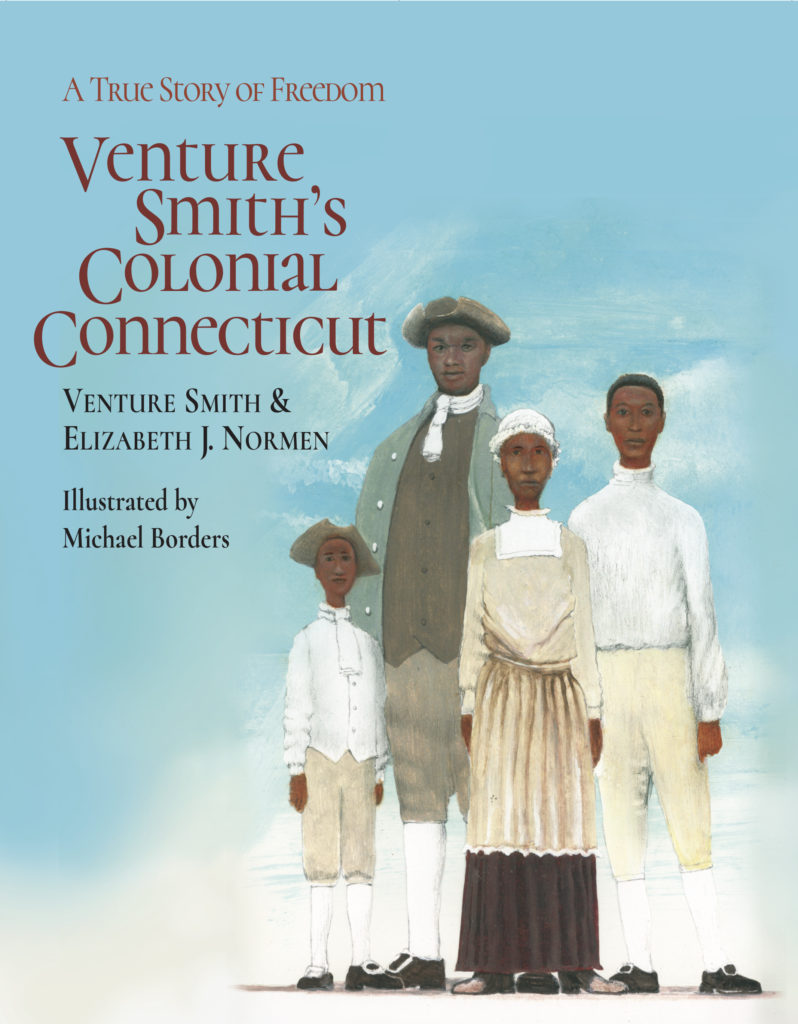 The first book for middle school kids and up to tell the story of Connecticut’s founding through the words of Venture Smith.
The first book for middle school kids and up to tell the story of Connecticut’s founding through the words of Venture Smith.

